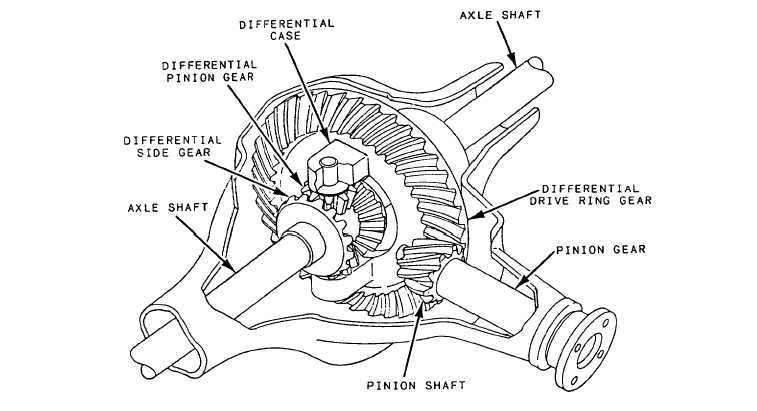on the outside of the turn must rotate faster and travel a greater distance than the wheels on the inside. This causes no difficulty for the front wheels on the usual passenger car because each wheel rotates independently. However, for the rear wheels to be driven at different speeds, the differential is needed. It connects the individual axle shaft for each wheel to the bevel drive gear; therefore, each shaft can turn at a different speed and still be driven as a single unit. Refer to the illustration in figure 11-17 as you study the following discussion on differential operation.
The bevel drive pinion, connected to the propeller shaft, rotates the bevel drive gear and the differential case which is attached to it. Within the case, the differential pinions are free to turn on individual pivots called trunnions. Power is transmitted to the axle shafts through the differential pinions and the side gears. The axle shafts are splined to the side gears and keyed or bolted to the wheels.
When the resistance is equal on each rear wheel, the differential pinions, side gears, and axle shafts all rotate as ONE UNIT with the drive gear. In this case, there is no relative motion between the pinions and the side gears in the differential case; that is, the pinions do not turn on the trunnions, and their teeth will not move over the teeth of the side gears.
When the vehicle turns a corner, one wheel must turn faster than the other. The side gear driving the outside wheel will run faster than the side gear connected to the axle shaft of the inside wheel. To compensate for this difference in speed and to remain in mesh with the two side gears, the differential pinions must then turn on the trunnions. The average speed of the two side gears, axle shafts, or wheels is always equal to the speed of the bevel drive gear.
To overcome the situation where one spinning wheel might be undesirable, some trucks are provided with a DIFFERENTIAL LOCK. This is a simple dog clutch, controlled manual] y or automatically, which locks one axle shaft to the differential case and bevel drive gear. Although this device forms a rigid connection between the two axle shafts and makes both wheels rotate at the same speed, it is used very little. Too often, the driver forgets to disengage the lock after using it. There are, however, automatic devices for doing almost the same thing. One of these, which is used rather extensively today, is the high-traction differential. It consists of a set of differential pinions and side gears

Figure 11-17. - Typical differential and axle assembly with ring and pinion.
Continue Reading